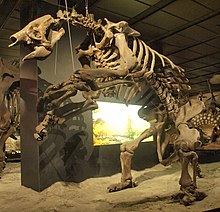| Eremotherium Temporal range: Early Pliocene-Early Holocene (Blancan-Rancholabrean (NALMA) & Montehermosan-Lujanian (SALMA)
~ | |
|---|---|

| |
| E. laurillardi at the HMNS | |
| Scientific classification | |
| Domain: | Eukaryota |
| Kingdom: | Animalia |
| Phylum: | Chordata |
| Class: | Mammalia |
| Order: | Pilosa |
| Clade: | †Megatheria |
| Family: | †Megatheriidae |
| Subfamily: | †Megatheriinae |
| Genus: | †Eremotherium Spillmann, 1948 |
| Type species | |
| †Megatherium laurillardi Lund, 1842
| |
| Other species | |
| |

| |
| Range of Eremotherium | |
Eremotherium (from Greek for "steppe" or "desert beast": ἔρημος "steppe or desert" and θηρίον "beast") is an extinct genus of giant ground sloth in the family Megatheriidae. Eremotherium lived in southern North America, Central America, and northern South America from the Pliocene, around 5.3 million years ago, to the end of the Late Pleistocene, around 10,000 years ago. Eremotherium was one of the largest ground sloths, with a body size comparable to elephants, weighing around 4–6.5 tonnes (4.4–7.2 short tons) and measuring about 6 metres (20 ft) long, slightly larger than its close relative Megatherium.
Eremotherium was widespread in tropical and subtropical lowlands and lived there in partly open and closed landscapes, while its close relative Megatherium lived in more temperate climes of South America. Characteristic of Eremotherium was its robust physique with comparatively long limbs and front and hind feet especially for later representatives- three fingers. However, the skull is relatively gracile, the teeth are uniform and high-crowned. Like today's sloths, Eremotherium was purely herbivorous and was probably a mixed feeder that dined on leaves and grasses that adapted its diet to local environments and climates. Like Megatherium, Eremotherium is suggested to have been capable of adopting a bipedal posture to feed on high-growing leaves.
Finds of Eremotherium are common and widespread, with fossils being found as far north as South Carolina in the United States and as far south as Rio Grande Do Sul in Brazil, and many complete skeletons have been unearthed.
Only two valid species are known, Eremotherium laurillardi and E. eomigrans, the former was named by prolific Danish paleontologist Peter Lund in 1842 based on a tooth of a juvenile individual that had been collected from Pleistocene deposits in caves in Lagoa Santa, Brazil alongside fossils of thousands of other megafauna. Lund originally named it as a species of its relative Megatherium, though Austrian paleontologist Franz Spillman later created the genus name Eremotherium after noticing its distinctness from other megatheriids.